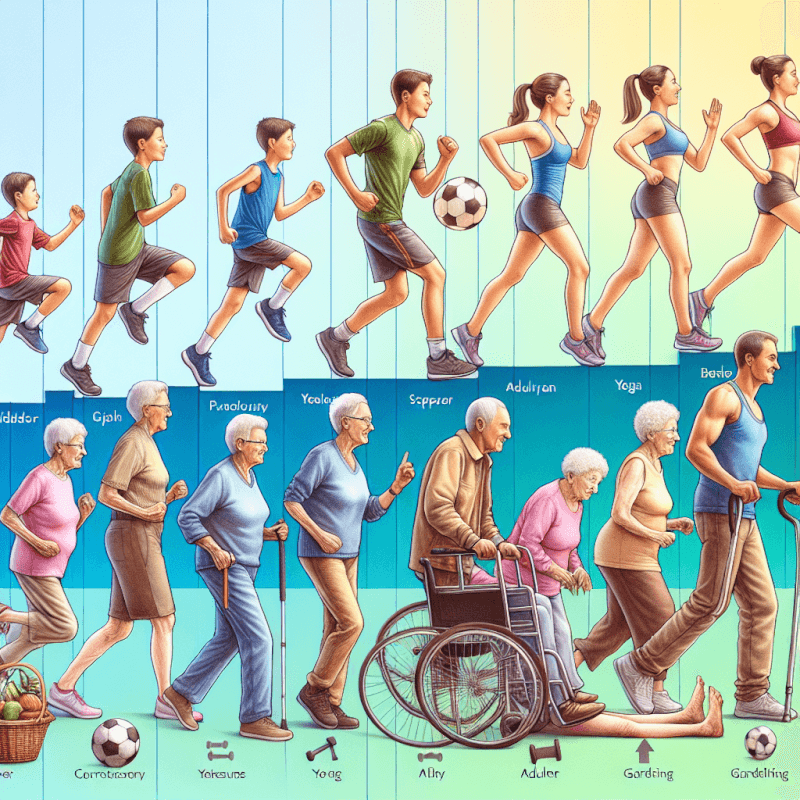As you embark on your fitness journey at your age, it’s important to consider any potential health risks that may arise from exercise. With age, our bodies undergo various changes, and certain precautions need to be taken to ensure a safe and effective workout. This article will highlight some common health risks that you should be aware of and provide you with practical tips to stay fit and healthy as you exercise. So, lace up your sneakers and let’s dive into the world of age-appropriate exercise! When it comes to staying active and maintaining a healthy lifestyle, it’s important to be aware of the potential health risks that may arise at different stages of life. As you age, your body goes through various changes, and certain conditions become more prevalent. By understanding these risks, you can take the necessary precautions to prioritize your health and well-being. In this article, we will explore some of the common health risks associated with different areas of the body as you get older, so that you can make informed choices and enjoy exercise safely.

Cardiovascular Health Risks
Cardiovascular health is of utmost importance, as the heart plays a vital role in supplying oxygen and nutrients to the body. However, as you age, there are certain conditions that may arise, increasing your risk of cardiovascular issues.
High Blood Pressure
One of the primary concerns for older adults is high blood pressure, also known as hypertension. This condition occurs when the force of blood against the walls of the arteries is consistently too high. Regular exercise can help manage blood pressure, but it’s important to monitor your levels and consult with your healthcare provider to ensure you are engaging in safe and appropriate activities.
Heart Disease
Heart disease encompasses a range of conditions that affect the heart, including coronary artery disease, heart failure, and heart attacks. As you age, the risk of developing heart disease increases. Regular exercise can help reduce this risk by improving heart health and promoting overall cardiovascular fitness. However, it’s important to start gradually and choose activities that align with your current fitness level and any existing heart conditions.
Arrhythmias
An arrhythmia refers to an irregular heartbeat, which can potentially disrupt the normal functioning of the heart. While exercise is generally beneficial for heart health, certain intense or strenuous activities may trigger arrhythmias in susceptible individuals. It’s important to be aware of any pre-existing conditions and consult with your healthcare provider to determine which exercises are safe for you and your heart.
Musculoskeletal Health Risks
As you age, your muscles, joints, and bones undergo changes that can increase the risk of certain musculoskeletal conditions. Taking proper care of these areas of your body can help maintain mobility and reduce the likelihood of injury and pain.
Joint Pain and Arthritis
Arthritis is a condition characterized by inflammation and stiffness in the joints. As you age, the risk of developing arthritis increases. Regular exercise, particularly low-impact activities such as swimming or cycling, can help manage joint pain and improve joint flexibility. It’s important to choose exercises that are gentle on your joints, and consult with your healthcare provider for guidance.
Osteoporosis
Osteoporosis is a condition that weakens bones, making them more prone to fractures. As you age, your bone density naturally decreases, increasing the risk of osteoporosis. Weight-bearing exercises, such as walking or weightlifting, can help strengthen bones and reduce the risk of fractures. However, it’s essential to prioritize proper form, use appropriate equipment, and consult with your healthcare provider to ensure safety.
Muscle Strains and Sprains
With age, muscles may become less flexible and more susceptible to strains and sprains. Regular exercise that includes stretching and strength training can help maintain muscle flexibility and reduce the risk of injuries. It’s crucial to warm up before exercising, listen to your body’s signals, and avoid overdoing it to prevent muscle strains or sprains.
Respiratory Health Risks
Maintaining a healthy respiratory system is essential for overall well-being, as it ensures efficient oxygen exchange and proper lung function. However, certain respiratory conditions become more common as you age.
Asthma
Asthma is a chronic condition that causes inflammation and narrowing of the airways, leading to symptoms such as wheezing, shortness of breath, and chest tightness. Regular exercise is beneficial for individuals with asthma, as it can improve lung function and overall respiratory health. However, it’s important to consult with your healthcare provider to determine which exercises are safe for you and to manage symptoms effectively.
Chronic Obstructive Pulmonary Disease (COPD)
COPD refers to a group of progressive lung diseases, including chronic bronchitis and emphysema, that make breathing difficult. Exercise is an important component of COPD management, as it can improve lung capacity and overall endurance. Engaging in activities such as walking or swimming can be beneficial, but it’s crucial to consult with your healthcare provider to develop a safe and effective exercise plan.
Shortness of Breath
As you age, you may experience a decline in lung function, leading to a feeling of shortness of breath during physical activities. Regular exercise can help improve lung capacity and reduce the sensation of breathlessness. However, it’s important to start slowly, listen to your body, and consult with your healthcare provider if you experience excessive shortness of breath or other concerning symptoms.
Metabolic Health Risks
Metabolic health encompasses various aspects of your body’s ability to process and utilize energy. As you age, certain metabolic conditions become more prevalent, requiring careful attention and management.
Diabetes
Diabetes is a condition characterized by elevated blood sugar levels. Regular exercise is essential for managing diabetes, as it can improve insulin sensitivity and help control blood sugar levels. Engaging in both cardiovascular and strength training exercises can have a positive impact on diabetes management. It’s important to monitor your blood sugar levels, consult with your healthcare provider, and adjust your exercise routine accordingly.
Obesity
Obesity is a condition characterized by excess body fat, which can increase the risk of various health issues, such as heart disease, diabetes, and joint problems. Regular exercise, combined with a balanced diet, is crucial for weight management and overall metabolic health. It’s important to engage in activities that you enjoy and that align with your fitness level, while maintaining a caloric deficit if weight loss is a goal.
Metabolic Syndrome
Metabolic syndrome refers to a cluster of conditions, including high blood pressure, high blood sugar levels, excess abdominal fat, and abnormal cholesterol levels, which collectively increase the risk of cardiovascular disease and diabetes. Regular exercise is a key component of managing metabolic syndrome, as it can help improve all of these risk factors. Consulting with your healthcare provider is essential to develop an appropriate exercise plan and monitor your progress.

Neurological Health Risks
The health of your brain and nervous system is crucial for cognitive function and overall well-being. As you age, certain neurological conditions become more prevalent and require specific considerations when engaging in physical activity.
Stroke
A stroke occurs when the blood supply to the brain is interrupted or reduced, resulting in damage to brain cells. Regular exercise can play a significant role in stroke prevention and recovery. Engaging in activities that promote cardiovascular health and overall fitness can help reduce the risk of stroke. It’s important to consult with your healthcare provider to determine which exercises are safe and appropriate for your specific situation.
Parkinson’s Disease
Parkinson’s disease is a progressive neurological disorder that affects movement and coordination. Exercise is an important component of managing Parkinson’s disease, as it can improve balance, strength, and overall mobility. Activities such as cycling or dancing can be beneficial, but it’s crucial to consult with your healthcare provider and work with a qualified professional to develop a tailored exercise plan.
Peripheral Neuropathy
Peripheral neuropathy refers to damage or dysfunction of the peripheral nerves, resulting in symptoms such as numbness, tingling, and loss of coordination. Regular exercise can help improve blood flow to the nerves and reduce symptoms. Low-impact activities such as swimming or tai chi can be particularly beneficial. It’s important to consult with your healthcare provider to determine which exercises are safe and to avoid any activities that may exacerbate symptoms.
Psychological Health Risks
The health of your mind is as important as the health of your body. As you age, certain psychological conditions may become more prevalent, and exercise can play a significant role in promoting mental well-being.
Anxiety
Anxiety disorders are characterized by excessive worry and fear, often accompanied by physical symptoms such as restlessness and increased heart rate. Regular exercise has been shown to reduce anxiety symptoms and improve overall mental well-being. Engaging in activities that you enjoy and finding ways to incorporate movement into your daily routine can help manage anxiety. It’s important to consult with your healthcare provider or a mental health professional for personalized recommendations.
Depression
Depression is a mood disorder characterized by persistent feelings of sadness and loss of interest in activities. Regular exercise has been shown to have a positive impact on depression, as it can increase the release of endorphins and improve mood. Engaging in activities that you find enjoyable, such as walking in nature or participating in group exercise classes, can be beneficial. It’s important to consult with your healthcare provider or a mental health professional for appropriate guidance and support.
Stress-related Disorders
Chronic stress can negatively impact both physical and mental health. Regular exercise is a powerful tool for managing stress, as it can promote the release of endorphins and provide a healthy outlet for tension and anxiety. Engaging in activities such as yoga or meditation, combined with cardiovascular exercise, can help reduce stress levels. It’s important to listen to your body’s signals and practice self-care to prevent overexertion.

Orthopedic Health Risks
Taking care of your bones, joints, and muscles is essential for maintaining mobility and preventing injuries. As you age, certain orthopedic conditions become more common and require attention when participating in physical activities.
Back Pain
Back pain is a prevalent condition, particularly in older adults, and can be caused by various factors such as muscle strain, arthritis, and disc degeneration. Regular exercise that focuses on strengthening the core muscles and improving posture can help alleviate back pain. Activities such as swimming or gentle yoga can be beneficial. It’s important to avoid high-impact exercises that may exacerbate symptoms and to prioritize proper form and technique.
Knee Injuries
Knee injuries, such as ligament tears or osteoarthritis, can significantly impact mobility and quality of life. Regular exercise that focuses on strengthening the muscles around the knee joint can help prevent injuries and reduce pain. Low-impact activities such as cycling or using an elliptical machine are generally safe for individuals with knee conditions. It’s important to consult with your healthcare provider or a physical therapist to develop an exercise program that suits your specific needs.
Shoulder Problems
Shoulder problems, including rotator cuff tears and frozen shoulder, can limit mobility and cause pain. Regular exercise that focuses on improving shoulder stability and flexibility can help prevent injuries and alleviate symptoms. Gentle exercises such as shoulder rolls or resistance band movements can be beneficial. It’s important to avoid exercises that cause pain or discomfort and to consult with your healthcare provider or a physical therapist for guidance.
Heat-related Health Risks
Engaging in physical activity in hot and humid environments can pose additional risks, particularly for older adults. It’s important to be aware of these risks and take precautions to prevent heat-related illnesses.
Dehydration
Dehydration occurs when your body loses more fluids than it takes in. During exercise, especially in hot weather, the risk of dehydration increases. Staying adequately hydrated by drinking water before, during, and after exercise is essential. It’s important to listen to your body’s signals and drink fluids even if you don’t feel particularly thirsty.
Heat Exhaustion
Heat exhaustion can occur when your body overheats, often due to prolonged exposure to high temperatures and inadequate fluid intake. Symptoms may include heavy sweating, nausea, dizziness, and fainting. To prevent heat exhaustion, it’s important to exercise in cooler parts of the day, wear lightweight and breathable clothing, and take regular breaks to rest and hydrate.
Heat Stroke
Heat stroke is a severe and potentially life-threatening condition that occurs when your body’s internal temperature rises to a dangerous level. Symptoms may include confusion, rapid heartbeat, and loss of consciousness. To prevent heat stroke, it’s crucial to avoid exercising in extreme heat, stay hydrated, and seek immediate medical attention if you or someone else exhibits signs of heat stroke.

Injury-related Health Risks
While exercise is generally beneficial for overall health, there is always a risk of injury if proper precautions are not taken. It’s important to be aware of these injury-related risks and take steps to prevent them.
Falls and Fractures
Falls and fractures become more common as you age, often due to factors such as impaired balance and weaker bones. Engaging in exercises that focus on balance, such as yoga or tai chi, can help reduce the risk of falls. Additionally, it’s important to ensure a safe exercise environment, wear appropriate footwear, and take precautions when exercising outdoors.
Tendonitis
Tendonitis refers to inflammation of the tendons, often caused by repetitive movements or overuse. It’s important to vary your exercise routine and avoid overtraining to prevent tendonitis. Gradually increasing exercise intensity, engaging in proper warm-up and cool-down routines, and incorporating strength training exercises can help protect your tendons.
Overuse Injuries
Overuse injuries can occur when repetitive stresses are placed on the body without adequate rest and recovery. It’s important to listen to your body’s signals and avoid pushing yourself beyond your limits. Incorporating rest days into your exercise routine, cross-training with different activities, and practicing proper form and technique can help prevent overuse injuries.
Age-related Health Risks
As you age, certain changes occur in your body that can impact your overall physical capabilities. It’s important to be aware of these age-related risks and adjust your exercise routine accordingly.
Decreased Flexibility
As you age, your muscles and connective tissues naturally become less elastic, leading to decreased flexibility. Engaging in regular stretching exercises can help maintain and improve flexibility. Activities such as yoga or pilates can be particularly beneficial for promoting flexibility.
Reduced Balance
Impaired balance becomes more common as you age, increasing the risk of falls and injuries. Engaging in exercises that focus on balance and coordination, such as tai chi or balance training exercises, can help improve stability and reduce the risk of falls. It’s important to choose activities that align with your current abilities and use support or assistance if needed.
Loss of Muscle Mass
With age, there is a natural loss of muscle mass and strength, known as sarcopenia. Regular strength training exercises can help combat this loss and maintain muscle mass. Incorporating resistance exercises, such as weightlifting or using resistance bands, into your routine can be beneficial. It’s important to start with lighter weights and progress gradually to avoid injury.
In conclusion, as you age, it’s crucial to be aware of the potential health risks associated with different areas of your body. By understanding these risks and taking the necessary precautions, you can continue to enjoy exercise safely and maintain your health and well-being. Remember to consult with your healthcare provider before starting or modifying any exercise routine, and listen to your body’s signals to ensure you exercise within your limits. Stay active, stay healthy, and enjoy the benefits of regular physical activity throughout your life.



